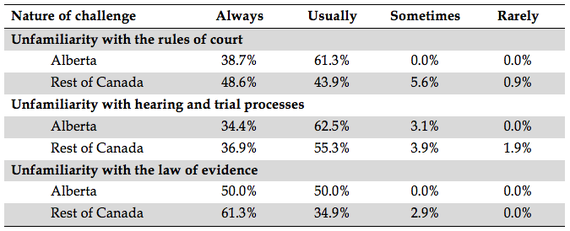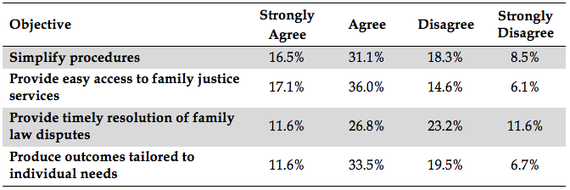Unified family courts: an established mechanism for improving access to justice
J.P. BoydThursday, December 4, 2014
Lawyers practicing in jurisdictions with multiple trial courts and no unified family court will be aware of the challenges facing litigants without counsel. First there’s choosing the right law, because of the overlapping federal and provincial legislative jurisdiction in family law matters. Then there’s choosing the right court, because of the trial courts’ simultaneous but asymmetric subject matter jurisdiction. And then there’s the question of the courts’ relative degrees of complexity, expense and accessibility, and the extent to which corollary social and legal support services are or are not embedded in the court process.
One obvious solution might lie in amalgamating the trial courts to provide litigants with one court, with easy to understand rules and processes that are proportionate to the nature of the dispute and specific to family law, that is integrated with the relevant social services. This is more or less the approach taken in parts of Manitoba, New Brunswick, Newfoundland and Labrador, Nova Scotia, Prince Edward Island, Ontario and Saskatchewan, where there is a single court for the resolution of family law disputes, but it seems to be off the menu in Alberta and British Columbia for reasons that escape me.
The unified family court concept is not a new one. British Columbia initiated a short-lived project in 1974, Manitoba, Ontario and Saskatchewan each launched pilot projects in 1977, and a committee of the Alberta Law Society recommended the establishment of a unified family court in that province in 1968. In fact, the 35th anniversary of the Hamilton Family Court, the first unified family court in Ontario, was celebrated just two years ago.
In essence, unified family courts recognize the special nature of family matters as a distinct area of the civil law and are meant to provide litigants with one-stop shopping, avoid a piecemeal approach to a family’s legal issues, and reduce the likelihood of duplication, delay and harassment through a multiplicity of proceedings. Ideally, a unified family court would have:
- limited judicial rotation between other courts, resulting in a dedicated bench with highly developed skills and expertise;
- specialized rules that create a simplified process, that provide for only those procedures that are necessary for family law matters, that can adapt to the complexity and importance of an issue, and that can evolve independent of the ordinary civil rules;
- both adversarial and non-adversarial dispute resolution processes; and,
- social and educational services related to family breakdown integrated into the court system and its dispute resolution processes.
Such a court should improve access to family justice and related social services, and produce outcomes that are better tailored to the needs of the users of the system and their children.
Makes sense, doesn’t it? Here’s the rationale for a unified family court given in Alberta in 1976 by a special committee composed of the province’s Chief Justice, judges from the superior and provincial courts, with representatives from the Law Society of Alberta and what was then known as the Department of the Attorney General:
Family law deals with the problems of husbands and wives arising from the breakdown of marriages. It deals with problems of the protection and support of children arising from the breakdown or lack of family relationships, and the problems arising from the unlawful conduct of children and juveniles. These are among the most numerous and the most serious and important problems with which society must deal, and it is imperative that society provide strong courts and efficient social services in order to deal with them.
The Committee is concerned that the numerous and varied problems affecting families are not being satisfactorily dealt with under the present divided court structure. The fragmented jurisdiction makes improvement very difficult. The Committee is convinced that the time has come when important changes and solutions can be implemented only if a Family Court is created with original exclusive jurisdiction over the entire field of matters affecting the family.
And yet here’s how one commentator, lawyer and academic Michelle Christopher, described the state of the family justice system and the rationale for a unified family court in 2004:
Access to justice has long been a concern to the public, particularly in family law disputes, where parties lack the deep pockets to provide funds to sustain the type of prolonged and costly litigation that is common in corporate and commercial law contexts. … [It] has been argued that family law litigants are at a distinct disadvantage in trying to proceed without legal counsel, because the jurisdiction for family law problems is not limited to one level of court, or in Calgary, even to one court building! The public has long complained, and with good reason, that it is difficult to know whether their matters will be heard in Provincial Court or in the Court of Queen’s Bench. …
The public is not expected to be entirely conversant with issues of legislative jurisdiction, which require federal matters such as divorce to be heard in the first instance in the Court of Queen’s Bench. The Provincial Court of Alberta has jurisdiction to hear all matters of “purely local and provincial concern,” including child welfare and domestic relations (non-divorce, guardianship, custody and access) matters relating to the children of unmarried or never-married parents, or separated parents who are not yet divorcing, except if the proceedings are to establish paternity, in which case the Court of Queen’s Bench has jurisdiction. If you are a grandparent seeking access to your grandchild, your matter will be heard in the Provincial Court. In the case of child support, matters are also heard in the Court of Queen’s Bench, unless you are bringing an application for the reciprocal enforcement of a child support order from another province, in which case you will be heard in the Provincial Court, and so on. You get the picture. Except that it’s totally confusing to members of the public, and does affect access to justice.
Sadly, the complexity of the family justice system has a direct impact on the ability of litigants to proceed without counsel. In a 2014 survey of 167 judges and family law lawyers conducted by the Canadian Research Institute for Law and the Family and two prominent academics, all Alberta respondents said that special challenges always or usually arise because of unrepresented litigants’ unfamiliarity with the rules of court and the law of evidence, and 96.9% said that challenges always or usually arise because of litigants’ unfamiliarity with court processes.

You can read about how these issues compound the other challenges faced by litigants without counsel elsewhere in this blog.
Interestingly enough, although unified family courts are far from perfect, they do in fact generate the results expected of them. According to a 2006 report prepared by the Institute and Nicholas Bala for the federal Department of Justice, most family law lawyers practicing in regions with unified family courts said that they have simplified court procedures, provide easy access to family justice services and produce outcomes tailored to individual needs. What they’re less good at is providing a speedy resolution to family law disputes. This is what the 164 lawyers surveyed said about four key performance benchmarks:

There are, of course, two main difficulties with implementing a unified family court in Alberta and British Columbia. First, both the provincial governments and the federal government need to cooperate with each other to set up the new court and address the jurisdictional issues arising from the merger of a court with statutory jurisdiction and a court with inherent jurisdiction. Second, it can’t cost too much. None of the governments in question are going to be keen about spending money on a family law court even though the national divorce rate is 40.7% and 21.5% of Canadian children live in lone-parent families. Neither problem is, in my view, insurmountable.
In 1978, the Alberta Law Reform Institute published two papers that address the constitutional issues and continues to be relevant, a paper expressing legal opinions on the question of jurisdiction (PDF) and a paper laying out the structure of a proposed unified family court (PDF). In the jurisdiction paper, one of the authors concludes that the provincial Governors General may grant limited appointments to provincial judges to enable them to undertake the functions of federally-appointed judge; this, however, carries with it the concern that the federal government would be responsible for their salaries which is, presumably, a non starter. In the proposal paper, the authors discuss the possibility of the federal government giving provincial judges special limited warrants to exercise some of the powers of a federal judge.
This second idea may be the better solution, as it would preserve the expertise of the provincial court judges who already are partial specialists in family law matters, incorporate them as members of a new court with their federally-appointed peers, and leave their salaries paid by the provincial government. In the current atmosphere of fiscal restraint, I cannot imagine either level of government being asked to commit significant new resources, much less absorb the burden of a boatload of judges currently paid by the other!
Both of the ALRI papers need to be read to get a thorough handle on the constitutional issues. I note, however, the provisions of s. 25 of the Divorce Act, which allow the provinces to “make rules applicable to any proceedings” under the act, including rules:
(a) regulating the practice and procedure in the court …
(e) prescribing and regulating the duties of officers of the court …
(g) prescribing and regulating any other matter considered expedient to attain the ends of justice and carry into effect the purposes and provisions of this Act.
These provisions were introduced with the 1985 act and seem to me to extend an authority to the provincial governments that was not available when ALRI’s reports were published in 1978 and may offer further options.
Back to the cost issue for one moment. I strongly suspect that a unified family court will ultimately save more money than what is expended under the current system, even with the costs of an expanded court administration which incorporates a broader range of dispute resolution options and social services added in. If a unified family court promotes the rational, reasonable settlement of family law disputes, it will reduce the number of files headed to trial and the resulting savings over the existing litigation-focussed system will be significant.
At the end of the day, report (PDF) after report (PDF) has commented on the barriers that inhibit access to justice, and prominent among them is the labyrinthine complexity of a judicial system involving two courts with concurrent but incongruent jurisdiction, with different rules, processes and forms. This barrier assumes a new significance in light of the ever-increasing numbers of litigants involved in civil court proceedings without counsel, numbers which represent anywhere from 50% to 80% of the court docket depending on the jurisdiction you’re looking at. A simpler, more streamlined process, with a new and heightened emphasis on integrated social services, managed by a bench of specialist judges, may not be the only or the best answer for family law litigants, but it’s a concept that has proven to work elsewhere and surely deserves to be considered.
This post is based on an article originally written for and published by LawNow Magazine. It is reposted from the Access to Justice Canada Blog.



